Medieval custard tarts generally contain similar basic ingredients consisting of a milk product, eggs and spices. Frequently they also contain fruit, but not always. What varies between the recipes is the ratio of these ingredients as well as which spices and fruits, if any, were used. Some used butter, others cream or even Almond Milk. The eggs might be whole or just the yolks. All of this would obviously affect how the finished custard tasted once baked, including texture and richness. Other variations were simply due to regional or seasonal availability of ingredients and flavorings including the sweetener being used, such as sugar or honey. I use modern alternative sweeteners (generally Lakanto Monk Fruit) due to dietary restrictions. For this same reason, I also use alternatives to traditional wheat flour. In addition to Cinnamon and Saffron, Ginger was one of the most common spices added to Medieval custards. Inspired by a combination of period recipes, my custard tart is filled with figs and dried fruit, while using fresh Ginger for its only spice.
The first two recipes are for Daryols/Dariolles, which are small custard tarts. From a Forme of Cury (England, 1390):
Daryols. Take creme of cowe mylke, oþer of almaundes; do þerto ayren with sugur, safroun and salt. Medle it yfere. Do it in a coffyn of ii yinche depe; bake it wel and serue it forth.
Translation: Take cream of cow milk, or of almonds; do there-to eggs with sugar, saffron and salt. Mix it fair. Do it in a coffin of two inch deep; bake it well and serve it forth.
The second is from an excerpt from Two Fifteenth-Century Cookery-Books (England, 1430):
Dariolles. Take wyne and fressh broth, Clowes, Maces, Mary, powder of Gynger, and Saffron, And lete al boyle togidre; And take Creme, (and if hit be cloutes, drawe hem thorgh a streynour,) And yolkes of egges, and medle hem togidre, and powre the licoure that be mary was soden in, thereto; And then make faire cofyns of fyne paast, and putte the mary there-in, and myced dates And streberies, if hit be in time of yere, and sette the Coffyns in re oven, And lete bake a litull while, And take hem oute, and putte the licour thereto, And lete hem bake ynoun.
Translation: Take wine and fresh broth, Cloves, Maces, Marrow, powder of Ginger, and Saffron, And let all boil together; And take Cream, (and if it be clotted, draw them through a strainer,) And yolks of eggs, and mix them together, and pour the liquid that the marrow was seethed in, thereto; And then make fair coffins of fine paste, and put the marrow therein, and minced dates And strawberries, if it be in time of year, and set the coffins in the oven, And let bake a little while, And take them out, and put the liquid thereto, And let them bake enough.
While the above custard tarts were small, individual servings, my custard tart is like this 15th century Italian Diriola, a full-sized custard pie. From the Libro de Arte Coquinaria by Maestro Martino de Como (1465).
Diriola – Conciarai la pasta in forma d’un pastello et impiela ben di farina che sia deritta cocendola in la padella tanto che sia un poco secca. Et facto questo cava for a la ditta farina et prendirai alcuni rosci d’ova, de lo lacte, del zuccaro, et de la cannella. Et facta di queste cose una compositione la mettirai in la dicta pasa facendola cocere al modo de una torata, movendola tutta volta et volgendola spesso col cocchiaro. Et como tu vidi che incomincia a pigliarsi sopragiogneli un poca d’acqua rosa, et volta bene collo cocchiaro. Et quando serà fornita di prendere, serà cotta. Et nota che non vole cocere troppo et vole tremare como una ionchata.
Translation: Form the dough into the shape of a deep pie and fill it completely with flour so it will keep its shape; cook it in a pan until it is somewhat dry. And when this is done, remove the flour and take some egg yolks, milk, sugar, and cinnamon. When these things are made into a mixture, put it into the pastry, cooking it like a tart, moving it from time to time and stirring with a spoon. And when you can see it starting to set, pour on some rose water and stir well with a spoon. And when it has set completely it is cooked. Note that is should not cook too much, and that is should quiver like a junket.
Figs, raisins, and wine were also a classic Medieval flavor combination as found in many recipes such as this one from the fourteenth-century culinary manuscript Curye on Inglysch.
Rapey. Take half fyges and half raisouns; pike hem and waishe hem in water. Skalde hem in wyne, bray hem in a morter, and drawe them thurgh a straynour. Cast hem in a pot and therwith powdur of peper and oother good powdours; alay it vp with flour of rys, and colour it with saundres. Salt it, seeþ it & messe it forth.
Translation: Take half figs and half raisins, pick them and wash them in water. Scald them in wine, break them in a mortar, and draw them through a strainer. Cast them in a pot and (add) there with powder of pepper and other good powders (ground spices); lay it up with rice flour, and color it with saundres (Red Sandalwood used as a colorant). Salt it to taste and serve it forth.
Another classic recipe containing similar ingredients to my tart, those being figs, raisins, wine, and ginger is Fygey, or Fig Pudding, also from Forme of Cury (1392).
Take almaundes blanched, grynde hem and draw hem up with water and wyne: quarter fyges, hole raisouns. Cast þerto powdour gyngur and hony clarified, seeþ it well & salt it, and serue forth.
Translation: Take blanched almonds, grind them and draw them up with water and wine: quarter figs, whole raisins. Cast thereto powdered ginger and clarified honey, season it well and salt it and serve it forth.
One last example of a period Custard Tart with fruit is the Tardpolene found in the Anglo-Norman Culinary Collections.
Tardpolene (The original recipe translated) – Take and combine flour and sugar, and mix into pastry with almond milk; make cases of this pastry two fingers in height; then take pears, dates, almonds, figs, and raisins, and put in liquid and spices and grind together; add egg yolk and a piece of good, soft cheese, not too old, and plenty of whole eggs; then put them [the pastry cases filled with the above mixture] to cook; brush the tops with egg yolk; then serve.
Why Custard Tart with Figs and dried fruit?
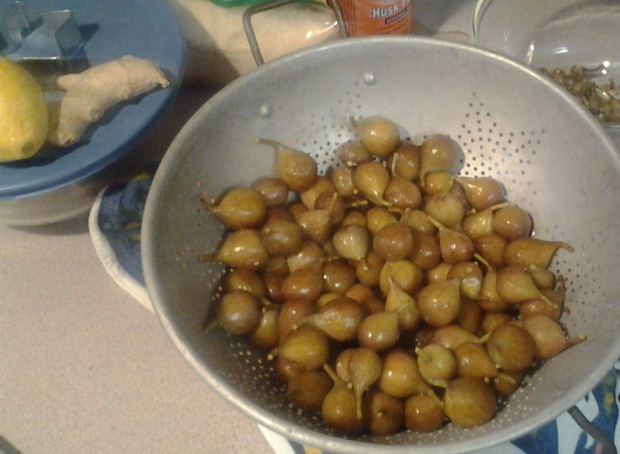
Frozen when harvested. Now thawed and ready to use!
We are blessed to have a fig tree on our new property. When our figs were ripening, I had to rush to harvest them every morning to prevent the birds from getting them first! Because I was only harvesting a handful or two a day, I put them into the freezer for future use. As Yule approached, I knew I wanted to bake them into a period-style custard tart. As I did not have raisins on hand at the time, I used dried cranberries instead, which resulted in a festive, tangy tart. Although raisins would be the period choice, any dried fruit such as dates or currents could also be used. The day before I was going to be baking, I took the figs out of the freezer and placed them into the refrigerator to thaw.
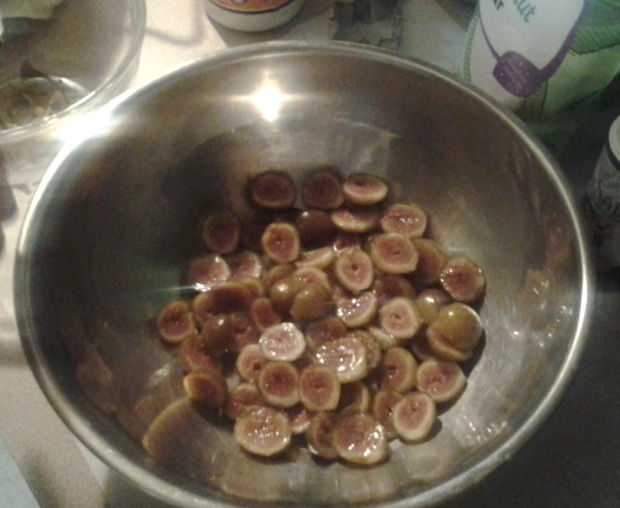
Cleaned, stemmed and halved
Paest Royall – Royal Pie Crust
To Make Pyes …. yf you wyll have paest royall, take butter and yolkes of egges and so tempre the flowre to make the paeste.
Translation: To make pies …. If you will have paste royal, take butter and yolks of eggs and so temper (blend with) the flour to make the paste.
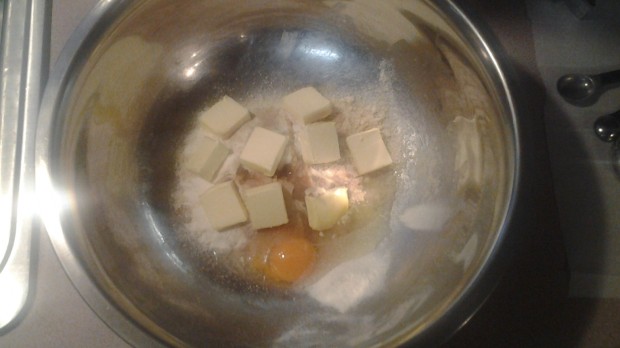
I cut in the butter by hand with two knives or a pastry cutter, if you have it. Then I mix with a large, wooden spoon. Finally I press into the pie dish instead of rolling it out like conventional pie crust.
My grain-free version:
Preheat oven to 350º F. Grease a 9.5-inch deep dish pie pan.
1/2 cup Butter (unsalted)
1 Egg
3/4 cup Blanched Almond Flour*
1/4 cup coconut flour*
2 tbsp Psyllium Husk Powder*
1 tsp Xantham Gum*
1 tsp Stevia Glycerite
Splash of Vanilla
Pinch Sea Salt
*1 cup of Wheat Flour can be used in place of the Almond Flour, Coconut Flour, Psyllium Husk Powder, and Xantham Gum if you prefer. You may also use a store-bought crust.

We’ve been grain-free for almost six full years so these ingredients are staples in our pantry/fridge!
In a medium bowl cut butter and egg into flour until crumbly. Mix in sweeteners. Press dough into bottom of pie pan and up the sides. Place in oven to blind-bake the crust. Bake for 15 minutes or until lightly golden brown. Remove from oven and set aside to cool.
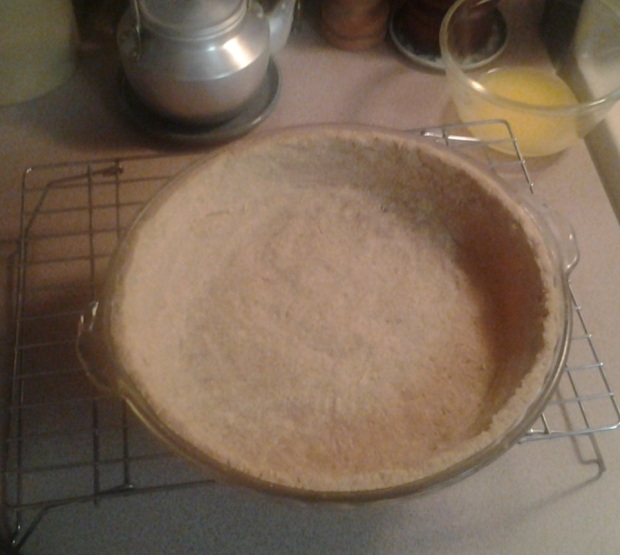
Grain-free pie shell blind baked and ready to use! use your favorite pie crust recipe or even a store-bought version.
Filling:
3 cups Figs, stemmed and halved
1 cup Raisins
1/2 cup Wine
4 large Eggs, beaten
1/2 cup Lakanto Monk Fruit*
1/4 cup Blanched Almond Flour
1/4 cup unsalted Butter, melted
1 large Lemon – zest and juice
1-2” piece of fresh Ginger – peeled and grated
*An equal amount of granulated sugar or sweetener of choice can be used
Once the crusts are baked and cooling, assemble the custard filling by combining eggs, sugar, flour, butter, lemon juice, lemon zest, and ginger in a medium bowl. If there is any liquid left in the raisins, drain that off, reserving the liquid to add to the other custard ingredients. Stir vigorously until well blended.

Crust filled with fruit and ready for the custard!
Gently mix the plump dried fruit with the figs and spread in an even layer into the cool piecrusts.
Pour the custard mixture over the mixed fruit. Use a fork to gently move the fruit to help settle the custard evenly. Bake at 350° F until center is set, about 40 minutes or more. Cool completely on a wire rack, about 2 hours. Cover and store in refrigerator.
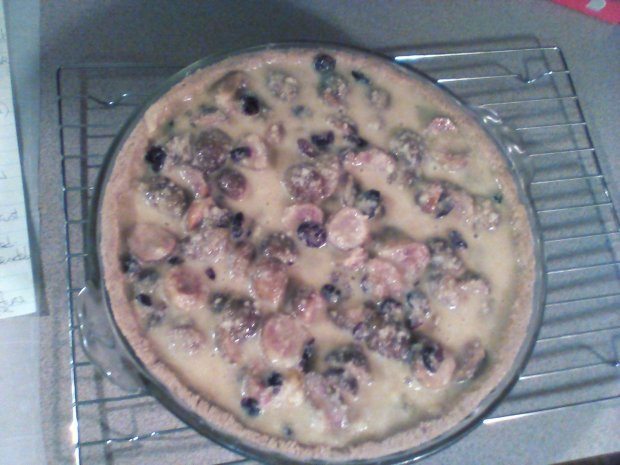
Custard poured over the top and ready to go into the oven
Overall, I am quite pleased with how these tarts turned out. I would have preferred to use eggs from our own hens but being midwinter they are not laying right now as we do not use artificial light in their coop. I took a risk and did not fill the piecrusts when I blind-baked them, and of course they rose up as a result of not being filled. However, as they cooled, they thankfully went back down neat as could be. I am looking forward to trying this recipe again next year, perhaps this time adding some chopped walnuts and a soft cheese to one of them in place of the raisins. I am also considering planting a few more fig trees!

The crust got a little dark on me despite covering the edges. Still, they were DELICIOUS!
Sources:
Hieatt, Constance B. and Sharon Butler. Curye on Inglish: English Culinary Manuscripts of the Fourteenth Century (Including the Forme of Cury). New York: for The Early English Text Society by the Oxford University Press, 1985.
Two fifteenth-century cookery-books: Harleian MS. 279 (ab 1430), & Harl. MS. 4016 (ab. 1450), with extracts from Ashmole MS. 1439, Laud MS. 553, & Douce MS. 55 Austin, Thomas, ed. London: Oxford University Press, 1964
https://www.academia.edu/15168285/Maestro_Martino_of_Como_The_art_of_cooking_-_the_first_modern_cookery_book Libro de arte coquinaria by Maestro Martino de Como (1465)
Frere, Catherine Frances. A Proper Newe Booke of Cokerye; Cambridge Eng.: W. Heffer & Sons, 1913. Print.
Friedman, David D., ed. A Collection of Medieval and Renaissance Cookbooks. S.l.: S.n., 1991. Print. Compiled by Duke Cariadoc of the Bow and Duchessa Diana Alena
Two Anglo-Norman Culinary Collections Edited from British Library Manuscripts Additional 32085 and Royal 12.C.xii Constance B. Hieatt & Robin F. Jones Speculum 61 (4):859-882 (1986)
The Medieval Kitchen – Recipes from France and Italy; Odile Redon, Francoise Sabban, and Silvano Serventi. Translated by Edward Schneider. Original line drawings by Patricia Glee Smith. © 1998
Take a Thousand Eggs or More – A translation of medieval recipes from Harleian MS. 279, Harleian MS. 4016, and extracts of Ashmole MS. 1439, Laud MS by Cindy Renfrow
Pleyn Delit – Medieval Cookery for Modern Cooks, Second Edition, Constance B. Hieatt, Brenda Hosington, and Sharon Butler
.
